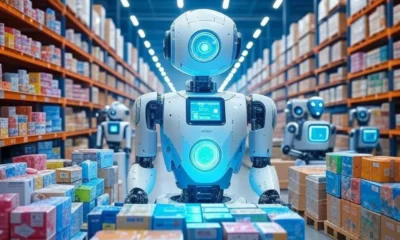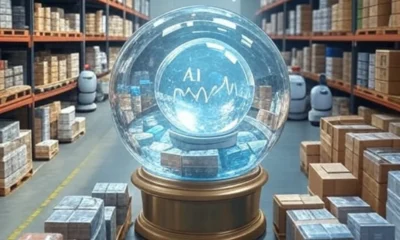Artificial Intelligence
How Smart Sensors and AI Together Enhance Last-Mile Customer Support
I use AI and smart sensors to track packages in real time and prevent last-mile delivery problems. This technology improves customer support and keeps people informed.
It would be as good as having actual time tracks on when your delivery has just arrived around the corner with no vague or missed deadlines.
I have heard the misery of when the packages fail to arrive on the correct clocks as well as zero help. That’s why I want to share how smart sensors and AI together make the last mile smarter, smoother, and customer-friendly.
Definition:
Last mile is a last portion of delivery trip to your door or business place starting at the warehouse.
In the United States, last-mile delivery plays a huge role in shaping how customers view your brand and your service. However, in many situations, conventional tracking lacks live updates leading to frustrations and delays, resulting in an excessive number of support calls. That’s where AI and smart sensors come in they give me better control, deeper insights, and a real-time connection with customers.
In today post, I will you through my process of using AI and sensor technology to provide quicker updates and those issues related to delivery. You will find that real-time visibility is not merely an improvement that logistics wise by far it makes customer service a proactive experience. So why is this technology so important now and what can you do with it to ensure you are a step ahead in 2025?
What Are Smart Sensors and Why Do They Matter?
I rely on smart sensors to collect real-time delivery data that helps me improve the customer experience every single day. Such miniature devices record the state of packages such as temperature, movement and location without having to do manual verification and follow ups.
That kind of automation makes it easier for me to make faster decisions and avoid costly last-mile delivery mistakes.
Smart sensors are physical devices connected through IoT that constantly track changes and share updates through digital systems in real time. In logistics, when I utilize them, I have an obvious idea of where my delivery is and how it is on the road. It will reduce the surprises to my personnel and give customers who desire high-quality service whenever they come with more confidence.
I have applied various kinds of sensors as per the requirements of the delivery, GPS based on location tracking, RFID on inventory as well as temperature based on perishable goods. These paraphernalia provide me with the information of how the parcels are being managed in the whole course throughout its journey and notably the last leg of the delivery stage. Wherever I implement them in my tracking system I achieve improved outcomes with reduced customer complaints and faster resolutions.
How Do AI and Smart Sensors Work Together to Improve Delivery Tracking?
I’ve seen firsthand how combining AI with smart sensors transforms the way I manage last-mile deliveries and customer communication.
AI uses the real-time data provided by the sensors and transforms it into valuable insights so that I can make decisions, as quickly as possible, and stay updated. Rather than react to problems, I am able to anticipate them and eliminate these issues before they affect my operation and customers.
The sensors can only inform me of the physical location of a package but the AI can inform me of the situation and what may occur in the future. As an example, when traffic reduces in speed, the AI reeschedule the delivery time and notifies me about it. It is as though you were able to have a smart assistant who reads the situation and then responds within a few seconds, rather than a few hours.
As my delivery trucks send communication to the system regarding the sensors found, AI is used to enhance accuracy and planning around that. This translates into less misdirected deliveries, less waiting time and improved wait messages to customers waiting at the door. This is my conjoined power to minimize errors, monitor all the activities, and avoid latencies in informing customers.
How Does Real-Time Tracking Improve Customer Visibility?
When I give customers real-time tracking, they feel more confident and less frustrated during the final stage of delivery. Customer service representatives also do not need to call their support team when they can check on their device and see where their package is at the moment.
Such visibility creates reliability and ensures that people do not guess and feel anxious about missed deliveries.
Sometimes, I even track package conditions like temperature or movement using sensors during last mile delivery for sensitive items.
Such extent of transparency converts a mere delivery into an excellent service experience that customers recall and enjoy.
What Can AI Learnings Do to Drive Proactive Customer Service?
There is no wait time based on customer complaint calls about deliveries anymore-I get insights into AI and contact my customers in advance before things do not go right. Using data available in real-time, AI allows me to be notified when everything has a chance of going bad, so I can act even before the customers realize something is wrong. This kind of proactive support has changed the game for how I manage last-mile delivery and customer communication.
My virtual assistants and chatbots directly interface to data in AI and sensor systems to provide immediate responses with data on location of or delays in delivery. In a situation where there would be a delayed package or delay within traffic, my system would inform the consumer automatically without withdrawing information manually. This equates to decreased support tickets and quicker resolutions even when there are high volume shipping days or seasonality.
How Does This Technology Avoid Delayer in Delivery and Failure?
I use AI with smart sensors to spot potential delivery issues before they turn into real problems that frustrate my customers. AI system observes sensor-based data concerning vehicles and notifies me that something seems to be wrong with them or it is traffic jammed.
That will enable me to redirect packages, or deliver assistance ahead of a delivery being delayed or not arriving at all.
Upon sensing heavy traffic or blockage of roads, AI will immediately change the path to ensure that things progress without wasting time.
I do not need to wait until the driver calls me or I get customer complaints because the AI will react within a shorter time than a manual process would. That has helped me not miss urgent deliveries as well as stay in good standing during the high shipping period.
Another great success of mine is the presence of the sensors to identify package tamper or temperature during the movement. AI interprets those notifications and assigns them red flags as soon as they occur to allow me to safeguard high-value or sensitive consignment against incurring damages. Additional layer of protection assists me in delivering not only faster, but safer without returns or unsatisfied customers.
What Are Some Real-World Success Stories Using AI and Smart Sensors?
When I first started using AI and smart sensors, I wasn’t sure how much they would actually improve customer support. But after seeing the results in real-world use, I realized just how powerful this technology is for last-mile delivery. Multinational logistics firms are already enjoying tremendous gains with the same tools that I use today.
They study conditions in real-time such as traffic, weather and how vehicles are performing in order to keep drivers on the road without delay. That has assisted them to shorten delivery time, save fuel, and enhance consumer satisfaction through peak seasons.
I’ve also seen mid-sized eCommerce brands use smart sensors to track sensitive shipments like food, medicine, or electronics. AI allows them to track the whole process and notify the customer when temperature is deformed or damage is examined during transportation. Fact that such proactive communication instills confidence between the company and the customers and makes the customer confident in the power of the brand to take care of them.
Why American retailers and logistical managers have to be interested in this technology?
Being a retailer or a manager of logistics in U.S., I know how competitive and demanding last-mile delivery has become lately. Customers expect quick, transparent and responsive updates and they no longer put up with confusion nor delay as they used to do in the past. Using AI and smart sensors helps me meet those expectations and stand out from competitors that still rely on outdated systems.
Technology helps me to minimize a failure of delivery, reduce useless returns, present a smaller number of concerns to my support team.
This implies reduced expenses, enhanced business performances and improved consumer experiences in the entire nation. Every time I add automation and real-time tracking, I notice smoother workflows and higher satisfaction rates in my reviews.
It is also my experience that when customers have real-time alerts and visibility of the delivery they increase their chances of ordering and referrals. Such devotion directly affects my bottom line and assists me in expanding without having to increase money spent on marketing and support. In a crowded U.S. market, using smart sensors and AI is one of the smartest moves I’ve made to stay ahead.
What Does the Future Look Like for AI and Sensor-Based Tracking?
When I look ahead, I see AI and smart sensors becoming even more advanced and integrated into last-mile delivery systems. Latest technologies such as 5G and edge computing will assist in more quick processing of sensor data at the place of delivery or warehouse. It implies that I will have immediate information without having to wait on cloud systems to capture every bit of information, and I will be more likely to be accurate and increase my efficiency.
I hope that AI will begin to learn more with every delivery to predict traffic and delays, as well as customer behaviour, even smarter. I will have time to anticipate potential problems instead of responding to problems because I will be able to readjust on the fly what I am providing. It will assist in keeping me one step ahead of the customer expectations particularly as on-demand delivery continues to increase in popularity in the U.S.
I think that in the future, AI systems will most likely go ahead and customize the delivery experience according to the specific customer preferences or habits. Certain customers may desire text messages, some may prefer the app notifications or voice assistants, and AI will adapt to suit them. It is no longer a matter of speedy delivery but rather the process of delivering every time a personal experience that an individual trusts.
Final Word: smarter deliveries begin with AI and sensors:
From my own experience, combining AI with smart sensors has completely changed how I manage last-mile customer support. I no longer make guesses as to where a package is or wait until something goes awry instead I am able to track it in real time with confidence. That has assisted me to improve on the accuracy of deliveries, decrease the delays, and provide my customers with a significantly improved overall experience.
Big logistic companies do not have exclusive ownership of these tools any more. They have worked very well in both small and mid size operations. They make me stay competitive,communicate with my staff, and ensure that my clients are never out of control with their deliveries. In case you are interested in making last-mile work better, I strongly suggest also reading about the benefits of AI and sensors not just on them. Well, now I would just like to know- Have you ever used AI or sensors to deliver? What are your issues around last-mile support? Tell me so in the comments and make sure to share this post should you find it helpful!
-

 Artificial Intelligence8 months ago
Artificial Intelligence8 months agoHow to Use Grok AI: A Complete Guide
-

 Artificial Intelligence10 months ago
Artificial Intelligence10 months agoWhat is Artificial Intelligence? A Comprehensive Guide for Businesses and Enthusiasts
-

 Artificial Intelligence9 months ago
Artificial Intelligence9 months agoUnlocking the Power of Artificial Intelligence Tools
-

 Artificial Intelligence9 months ago
Artificial Intelligence9 months agoWhat is DeepSeek? Revolutionizing AI with Cutting-Edge Solutions
-

 Artificial Intelligence5 months ago
Artificial Intelligence5 months agoAI Technologies in Warehouse Automation:
-

 Artificial Intelligence5 months ago
Artificial Intelligence5 months agoPredictive Analytics for Demand Forecasting:
-

 Artificial Intelligence6 months ago
Artificial Intelligence6 months agoMeta’s AI Push: The Standalone Assistant App Set to Rival ChatGPT
-

 Artificial Intelligence5 months ago
Artificial Intelligence5 months agoHow Artificial Intelligence is Revolutionizing Logistics:


